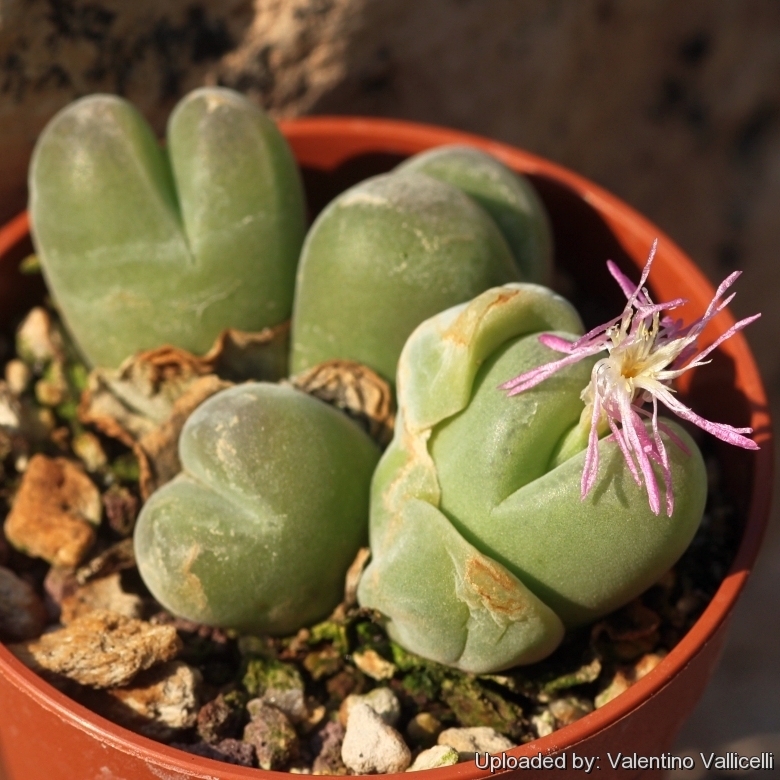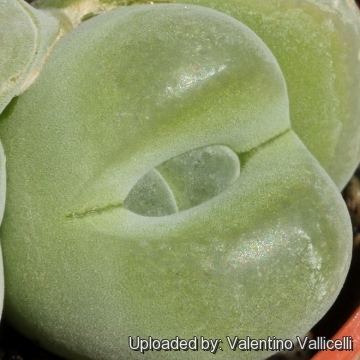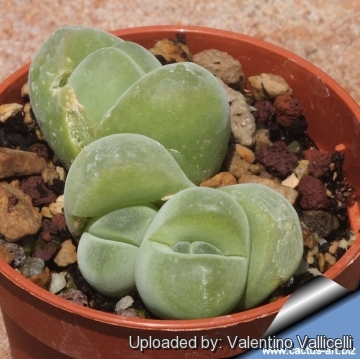Accepted Scientific Name: Gibbaeum nebrownii Tischer
Kakteen Sukk. 1: 151 1937

Imitaria muirii (Gibbaeum nebrownii) Photo by: Valentino Vallicelli
Origin and Habitat: Southern parts of the Western Cape, from the Ladismith area southwestwards to Swellendam and Northwards to the Touws River.
Habitat: They grow in the very dry winter rainfall area of the barren Little Karoo desert mostly in crevices on exposed, vertical shales completely embedded in the soil. In the hot and dry summer months they shrivel back so much into the soil that they often disappear underground and are very difficult to locate, blending perfectly with their surroundings.
Synonyms:
See all synonyms of Gibbaeum nebrownii
back
Accepted name in llifle Database:Gibbaeum nebrownii TischerKakteen Sukk. 1: 151 1937Synonymy: 4
back
Description: It is a small compact Conophytum-like plant with softly pubescent leaves for most of the year sunken in the ground. It branches forming small clumps or mats with several heads. It was firstly considered of hybrid origin: Conophytum x Gibbaeum.
Stem: Acaulescent.
Body (Paired leaves: Almost round to ovate about 2 cm across and 13-25 mm long, soft and fleshy, smooth and like velvet to the touch. Epidermis with microscopic hairs (papillae) from a broad base, branching apically 1-3 times. Wax cover amorphous breaking into fine sculptured plates. The paired leaves are, free, completely joined or joined at the base and enclosed at least basally by papery but tough, white sheaths developed from the old leaves of the previous seasons. Leaves of a pair characterise themselves through so-called Anisophylly, that one leaf of the pair grows somewhat longer than the other the apex is open or windowed to different degrees (like some conophytums).
Roots: It as a thick tap-root.
Flower: Pedicellate, petals 35-55, basally connate forming a tube of about 6 mm length, free parts spreading, pale pink (occasionally reddish-violet or white), whitish towards the entrance of the tube, filamentous staminodes 2.5-35, connate with the petal tube for about 4 mm, white, erect, stamens 14-20, shorter ones about at the entrance to the tube, longer ones a little higher, the 6 nectary glands at the base of the tube.
Blooming season: April.
Fruit: Winged, base a little rounded, top raised, but with low rims, 6 locules.
Bibliography: Major references and further lectures
1) Heidrun E. K. Hartmann “Illustrated Handbook of Succulent Plants: Aizoaceae F-Z” Springer, 2002
2) Gert C. Nel “The Gibbaeum Handbook, a Genus of Highly Succulent Plants, Native to South Africa” Blandford Press, 1953
3) Hermann Jacobsen “A handbook of succulent plants: descriptions, synonyms, and cultural details for succulents other than Cactaceae, Volume 1” Blandford Press, 1960
4)Werner Rauh “The Wonderful World of Succulents: Cultivation and Description of Selected Succulent Plants Other Than Cacti” Smithsonian Institution Press, 1984
5) Goldblatt, P. and Manning, J.C. 2000. "Cape Plants: A conspectus of the Cape Flora of South Africa." Strelitzia 9. National Botanical Institute, Cape Town.
6) Hilton-Taylor, C. 1996. "Red data list of southern African plants." Strelitzia 4. South African National Botanical Institute, Pretoria.
7) Vlok, J. and Schutte-Vlok, A.L. 2010. "Plants of the Klein Karoo." Umdaus Press, Hatfield.
 Imitaria muirii (Gibbaeum nebrownii) Photo by: Valentino Vallicelli
Imitaria muirii (Gibbaeum nebrownii) Photo by: Valentino Vallicelli Imitaria muirii (Gibbaeum nebrownii) Photo by: Valentino Vallicelli
Imitaria muirii (Gibbaeum nebrownii) Photo by: Valentino Vallicelli Imitaria muirii (Gibbaeum nebrownii) Photo by: Valentino Vallicelli
Imitaria muirii (Gibbaeum nebrownii) Photo by: Valentino VallicelliSend a photo of this plant.The gallery now contains thousands of pictures, however it is possible to do even more. We are, of course, seeking photos of species not yet shown in the gallery but not only that, we are also looking for better pictures than those already present.
Read More... Cultivation and Propagation: It is relatively is easy to grow. These plants grow on winter rain and head for summer dormancy. More or less dormant in summer.
Water: The plant requires little water; otherwise its epidermis breaks (resulting in unsightly scars). Water throughout the year although minimally in summer, (only when the plant starts shrivelling), but it will generally grow even in summer if given water. Water regularly in winter after the previous year's leaves have dried up. Requires good drainage.
Exposure: Keep cool and shaded from hot sun in mid-summer; it needs full sun or light shade in the other seasons.
Hardiness: Hardy to -2°C.
Manteinance: Ensure a very good ventilation. Avoid to repot frequently. This plant may stay in the same pot for many years. Plants grown in larger containers have frequently relatively poor flowers. It might improve when the plants are given their own, small individual pots.
Propagation: It can be reproduced both by cuttings and seeds. Take the cutting from a grown-up mother plant. Each cutting must contain one or more heads, along with a fraction of root.













